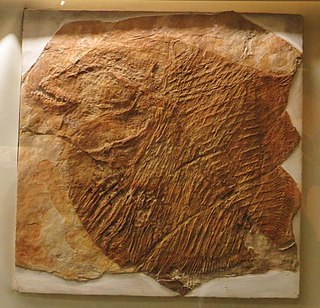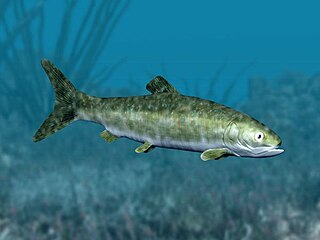
Dipterus is an extinct genus of marine lungfish from the middle Devonian period of Europe and potentially North America. The genus was established by Adam Sedgwick & Roderick Murchison in the year 1828. It was one of the first lungfish to be described by science.

Aphanepygus is an extinct genus of prehistoric marine holostean ray-finned fish that lived during the upper Cenomanian. It inhabited the former Tethys Ocean, with remains known from Lebanon and Croatia. Its exact affinities are uncertain, although it is usually recovered as a relative of the macrosemiids. However, other authorities recover it in the Ionoscopiformes.
Dinopteryx is an extinct genus of prehistoric beardfish from the Late Cretaceous period. It contains a single species, D. spinosus, known from the Santonian of Lebanon. It is the only member of the extinct family Dinopterygidae, which is considered a distinct family of the Polymixiiformes. It was previously placed in the genus Hoplopteryx.
Cryptoberyx is an extinct genus of prehistoric marine ray-finned fish that lived during the late Cenomanian stage of the Late Cretaceous. Two species are known from southern Europe and the Middle East, both part of the former Tethys Sea.
Aphnelepis is an extinct genus of prehistoric freshwater ray-finned fish that lived during the Late Jurassic epoch. It contains a single species, A. australis, from the Talbragar River beds of New South Wales, Australia.

Acrolepis is an extinct genus of prehistoric marine bony fish that lived from the Famennian stage of the Devonian to the early Triassic epoch. Some species from the Early Triassic of Tasmania are also ascribed to Acrolepis.
Austropleuropholis is an extinct genus of freshwater ray-finned fish that lived during the Late Jurassic. It contains a single species, A. lombardi, from the Kimmeridigian of the Democratic Republic of the Congo, from the terrestrial/freshwater series of the Stanleyville Formation.

Eichstaettia is an extinct genus of marine ray-finned fish that lived during the early Tithonian stage of the Late Jurassic epoch. It contains a single species, E. mayri from the Eichstätt Formation of Germany, which is part of the wider Solnhofen Limestone. It was an early stem-group elopiform, making it distantly related to modern tarpons and ladyfish. It was initially described as a species of Anaethalion.
Cyttoides is an extinct genus of prehistoric marine ray-finned fish that lived during the early Oligocene epoch in the western Paratethys Sea over Europe. It contains a single species, C. glaronensis from the Matt Formation of Canton Glarus, Switzerland. It was a zeiform related to the extant genus Cyttus.

Anaethalion is an extinct genus of prehistoric marine and freshwater ray-finned fish related to modern tarpons and ladyfish. It is known from the Late Jurassic to the Early Cretaceous of Europe and northeasterrn Asia, roughly encompassing the Tethys Ocean.
Athrodon is an extinct genus of marine pycnodontid fish that lived in shallow seas in what is now England, Germany, Spain and France from the Late Jurassic until the genus' extinction during the start of the late Cretaceous. The various species are very similar in splenial bone and tooth morphology to Mesodon. Otherwise, no articulated or complete specimen is known: all fossil specimens are bone fragments and disarticulated teeth. This genus is thought to be diagnosed by the presence of four lateral tooth rows. The presence of this genusin the Cretaceous is disputed, as the remains of Cretaceous species could belong to other genera.

Ctenothrissa is a prehistoric genus of marine ray-finned fish in the order Ctenothrissiformes. It contains a number of species known from the Late Cretaceous of England and Lebanon.

Coelodus is an extinct genus of marine and possibly freshwater pycnodont fish. It contains only one definitive species, C. saturnusHeckel, 1854, from the Late Cretaceous of Slovenia. Other species from the Late Jurassic to the Eocene have also been attributed to this genus based on isolated dental elements, but their assignment to Coelodus is uncertain, and this genus likely represents a non-monophyletic wastebasket taxon. A potential diagnostic trait is a prearticular tooth row with three regular highly elongated teeth.

Coccolepis is an extinct genus of prehistoric marine ray-finned fish in the family Coccolepididae. Originally including most species within the family, it is now restricted to two species from the Late Jurassic Solnhofen Limestone of Germany. The holotype of C. bucklandi, designated and described by Louis Agassiz, was thought to be lost but was later rediscovered in Neuchâtel.
Charitosomus is an extinct genus of prehistoric marine ray-finned fish from the Late Cretaceous, related to modern beaked salmons. They were nektonic carnivores in life.
Ceramurus is an extinct genus of prehistoric marine ray-finned fish from the Late Jurassic. It contains a single species, C. macrocephalus from the Purbeck Group of England.
Dinelops is an extinct genus of marine ray-finned fish from the Late Cretaceous. It contains a single species, D. ornatus, from the Cenomanian of England. It was initially and often continues to be classified in the Osmeroididae, a family of extinct elopomorph fish that are placed in either the Albuliformes or Elopiformes. However, other studies place Osmeroides in the Albuliformes and Dinelops in the Elopiformes.

Ichthyokentema ("fish-goad") is an extinct genus of stem-teleost fish that lived during the Late Jurassic. It contains one species, I. purbeckensis, which is known from the Purbeck Group of Dorset, England. I. purbeckensis was originally described as a species of Pholidophorus by William Davies in 1887, but was moved to its own genus by Arthur Smith Woodward in 1941.

Morrolepis is an extinct genus of prehistoric coccolepidid "palaeoniscoid" ray-finned fish that lived during the Late Jurassic and earliest Cretaceous epochs in Europe, Asia and North America.

Callipurbeckia is an extinct genus of marine semionotiform ray-finned fish from the Late Jurassic and Early Cretaceous periods. Fossils have been found in Germany, Tanzania, and England.













